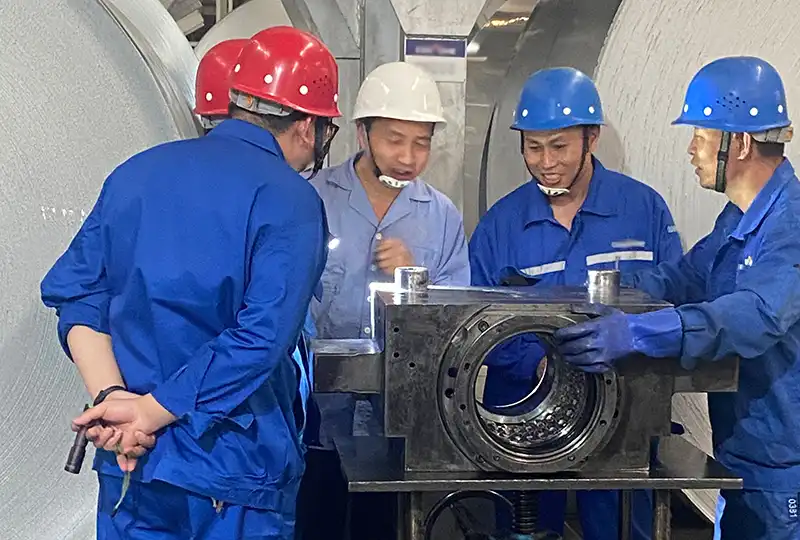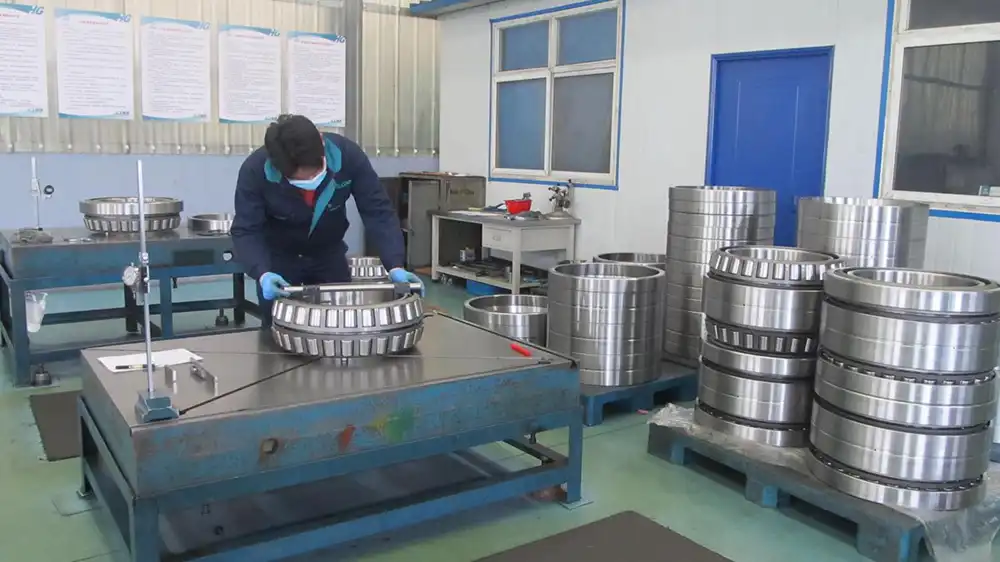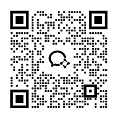How Do You Select the Right Single Row Thrust Ball Bearing for Your Machinery?
Selecting the appropriate single row thrust ball bearing is crucial for optimal machinery performance. These bearings handle axial loads in one direction, enhancing operational efficiency while reducing maintenance costs. This guide outlines key considerations for selecting the most suitable single row thrust ball bearing for your machinery.

What factors should you consider when selecting a single row thrust ball bearing?
Load Capacity Requirements
The primary function of these bearings is to handle axial loads, making understanding your machinery's load requirements essential. Calculate the maximum static and dynamic axial loads during operation, including peak loads during startup, shutdown, or unexpected situations. Single row thrust ball bearings have basic static load ratings (C0) and basic dynamic load ratings (C). Choosing a bearing with inadequate capacity leads to premature failure, while oversizing causes unnecessary costs.
Operating Speed Constraints
Rotational speed significantly impacts single row thrust ball bearing selection. At higher speeds, heat generation, lubrication effectiveness, and centrifugal forces become crucial. Single row thrust ball bearings have flat raceway designs that limit their suitability for high-speed applications. The speed limitation varies based on bearing size, cage type, and lubrication method. For high-speed operations, enhanced cage designs, optimized geometries, or superior lubrication systems may be necessary. The permissible load typically decreases as operational speed increases.
Environmental Conditions Impact
The operating environment plays a crucial role in bearing selection. Temperature, humidity, contaminants, and corrosive substances affect performance and lifespan. These bearings are available in various materials with different protective treatments. High-temperature applications may require heat-stabilized components or special lubricants. Corrosive environments need stainless steel bearings or specialized coatings. Dusty environments might require sealed or shielded bearings, while moisture exposure necessitates corrosion-resistant properties.
How does the installation process affect the performance of single row thrust ball bearings?
Proper Mounting Techniques
Installation significantly influences bearing performance and lifespan. Proper mounting requires meticulous preparation of surrounding components, ensuring shafts and housings meet dimensional and geometric tolerances. Mounting surfaces must be perpendicular to the shaft axis to avoid misalignment. Appropriate mounting tools should apply force evenly to the bearing ring being fitted. Many failures trace back to improper installation techniques like excessive force, applying force to the wrong ring, or creating misalignment. Cleanliness during mounting is paramount—even microscopic contaminants can damage precision-finished surfaces.

Alignment and Preload Considerations
Proper alignment is critical as these single row thrust ball bearings are sensitive to misalignment due to their design. Even slight misalignment can dramatically reduce service life by creating uneven load distribution. Flatness and perpendicularity of mounting surfaces must be carefully controlled. Preload—the application of predetermined axial force to eliminate clearances—enhances bearing rigidity, improves accuracy, and reduces vibration. However, excessive preload generates heat and friction, while insufficient preload allows axial play, reducing precision. The optimal preload varies depending on application requirements, operating conditions, and bearing design.
Lubrication System Setup
Establishing effective lubrication is critical. Proper lubrication reduces friction, dissipates heat, protects against corrosion, and seals out contaminants. The initial lubrication must be applied correctly—neither under-lubricated nor over-lubricated. Under-lubrication leads to metal-to-metal contact and rapid wear, while over-lubrication causes churning and elevated temperatures. The lubricant must be compatible with bearing materials and operating conditions. A well-designed system should include provisions for periodic relubrication, ensuring lubricant effectively reaches all critical surfaces.
What maintenance practices extend the life of single row thrust ball bearings?
Regular Inspection Protocols
Systematic inspections help identify potential issues before they escalate. Inspections should focus on key indicators including lubricant discoloration, visible damage to seals, vibration signatures, and temperature monitoring. Inspection frequency depends on machinery criticality, operating conditions, and historical data. Maintenance personnel should be trained on the unique characteristics and failure modes of these single row thrust ball bearings. Modern approaches incorporate sensors that continuously assess bearing condition, providing real-time data for condition-based maintenance decisions.
Lubrication Management Strategies
Effective lubrication management is perhaps the most important maintenance practice. A comprehensive strategy includes selecting appropriate lubricant type considering operating temperature, speed, load, and environmental conditions. Maintenance teams must establish optimal relubrication intervals and quantities, as over-lubrication can be as detrimental as under-lubrication. Lubricant condition monitoring through sampling provides insights into lubricant and bearing health. Advanced systems, including automatic lubricators, can improve reliability by ensuring consistent delivery of correct lubricant amounts.
Troubleshooting Common Issues
Expertise in troubleshooting enables quick identification and resolution of problems. Common issues include unusual noise (humming suggesting misalignment, clicking indicating contamination, squealing signaling lubrication failure), excessive heat generation, unusual vibration patterns, and premature wear patterns. A systematic approach involves collecting evidence, comparing findings against known failure patterns, and implementing appropriate corrective actions. Maintaining detailed records builds an institutional knowledge base specific to machinery and operating conditions.

Conclusion
Selecting the right single row thrust ball bearing requires careful consideration of load requirements, speed constraints, environmental conditions, proper installation techniques, and effective maintenance strategies. Following these guidelines will enhance machinery performance, reliability, and service life while reducing operational costs and downtime.
Luoyang Huigong Bearing Technology Co., Ltd. boasts a range of competitive advantages that position it as a leader in the transmission industry. Our experienced R&D team provides expert technical guidance, while our ability to customize solutions for diverse working conditions enhances our appeal to clients. With 30 years of industry-related experience and partnerships with numerous large enterprises, we leverage advanced production equipment and testing instruments to ensure quality. Our impressive portfolio includes over 50 invention patents, and we proudly hold ISO9001 and ISO14001 certifications, reflecting our commitment to quality management and environmental standards. Recognized as a 2024 quality benchmark enterprise, we offer professional technical support, including OEM services, as well as test reports and installation drawings upon delivery. Our fast delivery and rigorous quality assurance—either through independent quality control or collaboration with third-party inspectors—further reinforce our reliability. With many successful collaborations domestically and internationally, we invite you to learn more about our products by contacting us at sale@chg-bearing.com or calling our hotline at +86-0379-65793878.
References
1. Harris, T.A. & Kotzalas, M.N. (2023). Essential Concepts of Bearing Technology: Rolling Bearing Analysis. CRC Press, 6th Edition.
2. Eschmann, P., Hasbargen, L., & Weigand, K. (2022). Ball and Roller Bearings: Theory, Design and Application. John Wiley & Sons, 5th Edition.
3. SKF Group. (2024). SKF Bearing Maintenance Handbook. SKF Publications.
4. Hamrock, B.J., Schmid, S.R., & Jacobson, B.O. (2021). Fundamentals of Machine Elements. McGraw-Hill Education, 4th Edition.
5. Timken Company. (2023). Timken Engineering Manual: Thrust Bearings Selection and Application Guide. Timken Technical Publications.
6. NSK Ltd. (2024). NSK Technical Report: Advancements in Single Row Thrust Ball Bearing Design for Industrial Applications. NSK Technical Review, Vol. 89.

